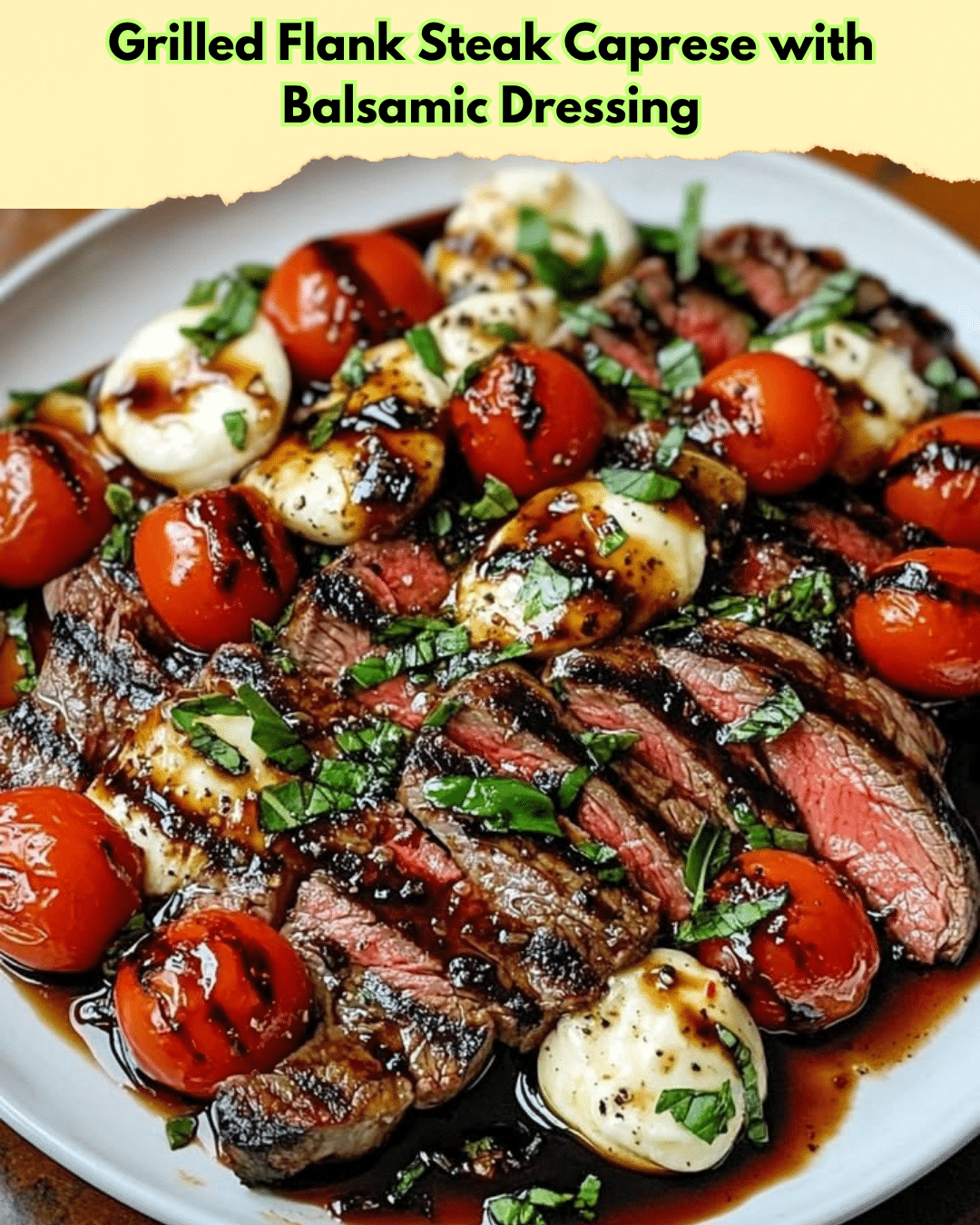Grilled Flank Steak Caprese with Balsamic Dressing: A Delightful Twist on a Classic
Experience the vibrant flavors of summer with this Grilled Flank Steak Caprese with Balsamic Dressing. This recipe takes the beloved caprese salad to a whole new level by adding perfectly grilled flank steak, transforming a simple dish into a satisfying entree. The combination of juicy tomatoes, creamy mozzarella, and fresh basil complements the robust flavors of grilled steak, all tied together with a tangy balsamic dressing. It’s a meal that pleases the eyes as much as the palate, perfect for outdoor gatherings or a delightful weeknight dinner.
This dish is a testament to the brilliance of Italian-inspired cuisine. As the steak grills to perfection, it fills the air with an irresistible aroma that captures the essence of summer barbecues. Each bite reveals a symphony of textures—from the tender steak to the soft mozzarella and crisp basil. The balsamic dressing, with its sweet and tangy profile, elevates the dish to gourmet status without a fuss. Whether you’re a seasoned cook or a kitchen novice, this recipe offers a rewarding experience that combines simplicity with culinary flair.
Quick Recipe Highlights
Flavor Profile: The Grilled Flank Steak Caprese combines rich, savory flavors from the steak with the freshness of tomatoes and mozzarella. The balsamic dressing adds a sweet-tart accent, making each bite journey through robust and delicate flavors.
Texture: Expect a delightful contrast, with the steak’s juiciness, the creamy cheese’s firmness, and the tomatoes’ freshness. The harmony of tender and crisp textures ensures a satisfying mouthfeel.
Aroma: The steak’s grilling releases smoky, savory notes that blend beautifully with the sweet, tangy scent of balsamic vinegar and the herbal fragrance of fresh basil.
Visual Appeal: This dish is as pretty as it is delicious, with vibrant reds from the tomatoes, velvety white from the mozzarella, and the bright green of basil against the perfectly charred steak.
Skill Level Needed: While grilling steak can be intimidating, this recipe’s clear instructions allow even novice chefs to achieve perfect doneness, bolstered by straightforward salad assembly.
Special Equipment: You will need a grill or grill pan to achieve those enticing grill marks on the steak, alongside a sharp knife for slicing and a bowl for whisking dressings.
Recipe Overview
Difficulty Level: Rated as moderate, this recipe requires basic grilling skills and timing awareness to ensure the steak reaches your preferred doneness without overcooking.
Category: This dish belongs to the entree category, perfect for a standalone meal or part of a larger spread at a barbecue or dinner party.
Cuisine: Inspired by Italian culinary traditions, this recipe marries classic caprese flavors with the global appeal of a perfectly grilled steak.
Cost: Flank steak, mozzarella, and fresh produce approximate cost is around $30, making it an affordable yet luxurious-feeling dish.
Season: Best enjoyed during the warmer months, this recipe takes advantage of peak-season tomatoes and fresh basil, but it can delight year-round.
Occasion: Whether it’s a casual family dinner, a romantic date night, or a festive gathering with friends, this dish fits perfectly with any occasion.
Why You’ll Love This Recipe
Taste and texture appeal: The Grilled Flank Steak Caprese with Balsamic Dressing offers a unique twist on the classic caprese salad. By introducing the robust flavor of grilled flank steak, the dish becomes more than just a simple salad—it’s a vibrant symphony of umami, tang, and sweetness. The texture of the dish is equally compelling, with the steak’s charred crust giving way to tender juiciness, which pairs beautifully with the creamy mozzarella and the crisp bite of fresh basil and tomatoes. This combination ensures every bite is a journey of discovery.
Convenience and preparation benefits: This recipe strikes a balance between sophistication and simplicity, making it an ideal choice for both novice cooks and seasoned chefs. The preparation is straightforward, requiring minimal equipment and basic cooking techniques, while still delivering impressive results. The use of a grill or grill pan ensures the steak is cooked to perfection in no time, while the salad components come together quickly. This means you can spend less time in the kitchen and more time enjoying your meal, whether for a casual supper or a larger gathering.
Nutritional advantages: Beyond its taste appeal, this recipe is also nutritionally balanced, offering high-quality protein from the flank steak, calcium and healthy fats from the mozzarella, and a wealth of vitamins and antioxidants from the fresh vegetables. The balsamic dressing, lightly sweetened with honey, adds flavor without piling on the calories. This makes the dish a great choice for those who care about healthy eating without compromising on flavor.
Social and entertaining value: Perfect for any occasion, the Grilled Flank Steak Caprese is a crowd-pleaser. It’s a talking point at dinner parties and equally suitable for a cozy family meal. The dish embodies the joy of sharing food with loved ones, helping you create memorable dining experiences. Impress your guests with this visually appealing and delicious dish, which seems more complex than it is.
Cost-effectiveness and accessibility: The ingredients in this recipe are not only easily accessible but also relatively affordable. Despite its gourmet outcome, the dish remains budget-friendly. The use of flank steak—a flavorful yet economical cut of beef—makes this an indulgence that doesn’t break the bank. It’s a fantastic way to treat yourself to a fancy meal without going overboard on expenses.
Historical Background and Cultural Significance
Origin story: Caprese salad originated in the island of Capri, Italy, during the post-World War I era. Its name references its origin, and its simple combination of tomatoes, mozzarella, and basil symbolized peace and calm, acting as a refreshing contrast to Italy’s tumultuous political climate.
Cultural importance: Over the years, caprese salad has grown from its humble beginnings into a staple of Italian cuisine, appearing in menus worldwide. Its colors mimic the Italian flag, making it a symbol of national identity, and its preparation emphasizes the importance of fresh, high-quality ingredients.
Evolution of the recipe: The traditional caprese salad has been adapted globally, incorporating various elements like arugula, avocado, or different cheeses. Adding grilled flank steak into the mix creates a hearty entree that satisfies protein lovers while retaining the dish’s light, refreshing nature.
Regional variations: Across Italy and beyond, caprese-style dishes vary based on local produce and culinary influences. While Italian versions typically remain true to the original, countries like the US might add balsamic glazes or spices, adapting the dish to suit differing palates while celebrating its freshness.
Ingredient Deep Dive
Flank Steak: Culturally considered a staple in many cuisines, the flank steak’s history dates back to being a prized cut for its affordability and flavor. It’s rich in protein and B vitamins, making it a healthy choice. When picking flank steak, look for even marbling and a deep, red color for freshness. Store it wrapped tightly in the refrigerator for up to three days or freeze for longer storage. For substitutions, skirt steak or even a well-marbled sirloin could provide similar results.
Mozzarella: A cornerstone of Italian cuisine, mozzarella’s creamy texture and mild flavor complement a range of dishes. Traditionally made with buffalo milk, today cow’s milk mozzarella is widely popular. High in calcium and protein, it’s essential to choose fresh mozzarella for the best flavor. Store it in its liquid or wrap tightly and refrigerate, using it within a few days of purchase. In a pinch, burrata or even bocconcini make great substitutes.
Common Mistakes to Avoid
Overcooking the steak: Always use a meat thermometer to ensure perfect doneness, and let the steak rest before slicing to retain juices.
Choosing low-quality ingredients: This recipe relies on fresh, high-quality produce and cheese to shine, so invest in the best you can find.
Imbalance in seasoning: Seasoning both the steak and the salad components is crucial to achieving a balanced flavor profile.
Skipping the dressing mix: Take the time to properly emulsify the balsamic dressing to prevent it from separating and losing its intended flavor impact.
Discarding basil stems: Chopped basil stems, like the leaves, can enhance salads with added flavor and texture.
Incorrect slicing of steak: Always slice the flank steak against the grain to ensure tenderness.
Mismatched cooking temperatures: Ensure the grill is preheated to the right temperature to achieve a perfect sear without burning.
Assembly timing errors: Assemble the caprese salad components just before serving to retain moisture and crunch.
Essential Techniques
Perfect grilling: Achieving a perfect grill on your steak enhances its natural flavors and gives it a delightful texture. Ensure the grill is adequately preheated, and avoid moving the steak too frequently to allow proper browning.
Emulsifying dressings: Properly emulsified balsamic dressing ensures a consistent texture and flavor distribution. Whisk vigorously or use a blender to combine all ingredients until smooth and well mixed.
Timing and resting: Resting grilled steak after cooking is crucial. It allows juices to redistribute evenly, resulting in a juicy and flavorful bite every time.
Knife skills: Mastering basic knife skills, like thinly slicing meat and preparing even produce pieces, contributes significantly to the dish’s overall appeal in texture and presentation.
Pro Tips for Perfect Grilled Flank Steak Caprese with Balsamic Dressing
Always season your steak thoroughly with salt at least 30 minutes before cooking to improve flavor absorption and tenderness.
Invest in a good-quality balsamic vinegar for the dressing, as it significantly influences the final taste of the dish.
For an extra punch of flavor, add a clove of minced garlic to the balsamic dressing during preparation.
If possible, try using heirloom tomatoes for their unique flavors and striking appearance in the salad.
Rest the steak for at least five minutes after grilling to ensure it retains its juices when sliced.
Slicing the steak thinly and against the grain ensures it remains tender and easy to chew.
Variations and Adaptations
Regional variations: In Naples, sliced grilled eggplant is a popular caprese addition, adding a smoky and meaty texture. Consider adding grilled vegetables for different textures and flavors.
Seasonal adaptations: During colder months, try using sun-dried tomatoes instead of fresh ones for a taste reminiscent of summer.
Dietary modifications: For a dairy-free version, replace mozzarella with avocado for creaminess, or a vegan mozzarella substitute.
Flavor variations: Enhance the balsamic dressing with a hint of honey for sweetness or a sprinkle of crushed red pepper for heat.
Texture modifications: Add crushed nuts such as pistachios or pine nuts to the caprese for added crunch.
Presentation alternatives: Stack salad layers for a sophisticated presentation or serve components deconstructed for a modern approach.
Serving and Presentation Guide
Plating techniques: Start with a base of fresh basil leaves, layer it with slices of juicy steak, then tomatoes, and finally mozzarella to emphasize the dish’s layered beauty.
Garnishing ideas: Top with a drizzle of balsamic glaze for extra shine and color contrast, and scatter freshly cracked black pepper for visually appealing texture.
Traditional accompaniments: Serve alongside boiled potatoes or a light pasta dish to keep with Italian tradition.
Modern serving suggestions: Pair this with a simple arugula and parmesan salad to add more greens to the table.
Temperature considerations: This dish is best served at room temperature for optimal flavors; avoid chilling as it mutes certain flavor profiles.
Portion control tips: Serve portions that integrate all components for balanced tastes in every bite; keep servings moderate to encourage savoring each flavor combination.
Wine and Beverage Pairing
Wine pairings: A medium-bodied red, such as Chianti or Sangiovese, effectively complements the steak and balsamic notes. Alternatively, try a Barbera for a fruity contrast.
Non-alcoholic alternatives: Offer grape juice or a sparkling water with a hint of lemon as refreshing non-alcoholic options that complement flavors without overpowering them.
Coffee/tea pairings if applicable: Following this meal, consider an Italian espresso to give diners an authentic culinary finish or a black tea with floral notes for mellow complementing.
Temperature considerations: Serve your wine slightly chilled to bring out its fruity notes and handle the steak’s richness without overwhelming your palate.
Serving suggestions: Offer wines in a decanter to help enhance their aroma through aeration, serving twice a bottle for group gatherings.
Storage and Shelf Life
Storage methods: Store leftover steak in airtight containers or wrapped tightly in foil to preserve moisture and avoid smells from other foods.
Temperature requirements: Refrigerate any leftovers at 40°F or below to inhibit bacterial growth, ensuring the retained steak’s quality.
Container recommendations: Use glass containers for storing salad components separately to keep them fresh for longer; avoid metal as it reacts with vinegar.
Signs of spoilage: Check for any unpleasant smells, slimy textures, or mold development before consuming leftovers.
Reheating instructions: Warm leftover steak slices briefly on a stove or microwave; avoid overcooking to prevent drying out.
Freezing guidelines: While mozzarella and fresh tomatoes aren’t freezer-friendly, the steak itself can be frozen in an airtight container for up to two months.
Make Ahead Strategies
Prep timeline: Begin preparations like chopping vegetables a few hours ahead and mixing the dressing earlier in the day to save time.
Storage between steps: Keep steak and salad ingredients separate until serving to maintain optimal texture.
Quality impact assessment: Steaks are best when grilled fresh, but pre-made balsamic dressing enhances flavor with time.
Assembly tips: Assemble the salad just before serving for freshness and a delightful mouthfeel.
Reheating guidelines: Warm steak slices gently; salad components should remain fresh, without reheating to preserve texture.
Fresh element additions: Add fresh basil leaves just before serving for their vibrant colors and refreshing taste.
Scaling Instructions
Halving the recipe: Simply halve ingredient quantities without altering cooking times; grill smaller steak portions evenly.
Doubling or tripling: Ensure you have a sufficient grill surface or prepare in batches, especially for larger gatherings necessitating increased steak quantities.
Equipment adjustments: Use larger mixing bowls for dressing and bigger serving dishes for doubled recipes to ensure proper mixing.
Timing modifications: If needed, additional steak may require slightly extended grilling time based on thickness, but remember to monitor closely.
Storage considerations: Store in multiple containers and label with preparation dates to prevent confusion; keep components separated.
Nutritional Deep Dive
Macro breakdown: This recipe provides balanced macronutrients—with protein from steak, fats from cheese, and carbohydrates predominately from produce.
Micronutrient analysis: Enjoy a boost of vitamin C from tomatoes and omega-3 fatty acids courtesy of olive oil in the dressing.
Health benefits: A nutrient-rich meal like this contributes to muscle recovery, bone structure, improved immune function, and heart health maintenance.
Dietary considerations: Designed for regular diets yet easily adaptable for gluten-free or low-carb lifestyles by modifying ingredients like mozzarella or adding leafy greens.
Portion analysis: Mind serving sizes; maintain balance by ensuring steak adequately pairs with salad components for holistic satisfaction.
Weight management tips: Keep in mind that despite healthy elements, a calorie-rich dressing should be used moderately; substitute full-fat mozzarella if counting calories.
Dietary Adaptations
Gluten-free: This recipe is naturally gluten-free, especially when taking care to confirm no gluten-containing ingredients are used.
Dairy-free: Replace mozzarella with vegan cheese options or nutritious avocado for dairy alternates to enjoy similar tastes and textures.
Vegan: Swap steak with well-seasoned grilled portobello mushrooms for a plant-friendly substitute, removing all animal-derived components.
Low-carb: Decrease tomato quantity or choose vegetables with lower carb counts for a recipe variation better suited for low-carb lifestyles.
Keto: Increase fat content by drizzling extra virgin olive oil on top more generously while substituting mozzarella with its higher-fat variant namesake.
Paleo: Since cheese isn’t paleo-compliant, try incorporating sliced avocado and crushed nuts for palatable textures—remaining true to primal eating.
Low-FODMAP: Reduce cheese and tomato amounts slightly for those sensitive, along with ensuring any vinegars used are low-FODMAP.
Other specific diets: Customize using diabetic-friendly ingredients or omit specific allergens such as nightshades for relevant followings.
Troubleshooting Guide
Texture issues: If the steak is overly tough, it may have overcooked; next time, using an instant-read thermometer will help achieve perfect doneness.
Flavor balance: For an unbalanced sweet or acidic dressing, gradually adjust honey/sugar or vinegar proportions till satisfied.
Temperature problems: If grill offers inconsistent heat, consider investing in a reliable thermometer for tracking and manual temperature management.
Equipment challenges: If lacking a grill, a broiler or cast iron skillet could replicate similar steaks care by adjusting heat specifics.
Ingredient substitutions: Replacing ingredients will impact results slightly different than originally intended due to taste and texture changes introduced.
Timing concerns: To stay organized, pre-plan all preparation and cooking steps while cross-checking against steam guidelines to avoid timing errors.
Recipe Success Stories
Community feedback: Readers loved how this recipe’s simplicity naturally highlighted high-quality ingredients—making it one they returned frequently.
Variation successes: Adding avocado or serving atop arugula was popular among readers adapting for personal tastes and dietary restrictions.
Adaptation stories: Accounts praised how effortlessly flexible the recipe proved, highlighting its adaptability across various cuisines and settings.
Reader suggestions: Try incorporating fresh jalapeños into the caprese for a slightly spicy variation readers found invigorating.
Photography tips: Many photographers found showcasing vibrant produce juxtaposed with char-grilled steak irresistible, recommending neutral backgrounds to emphasize rich color contrasts.
Frequently Asked Questions
What is the best way to grill steak for this recipe?
To ensure the best results, preheat your grill and season the steak adequately before grilling it for about 3-4 minutes per side until your preferred doneness is reached. Remember to let it rest after cooking.
Can I prepare the balsamic dressing in advance?
Absolutely, the balsamic dressing can be made up to three days in advance. Store it in an airtight container in the refrigerator and shake well before use.
What substitutes can I use for fresh basil?
If fresh basil isn’t available, try using parsley or arugula for a peppery twist, or a sprinkle of dried basil for a less intense flavor.
How can I prevent the mozzarella from getting too watery?
One effective method is to pat the mozzarella dry with a paper towel before adding it to the salad, which helps keep the dish from becoming soggy.
Is there a plant-based alternative to flank steak?
Yes, grilled portobello mushrooms or firm tofu marinated in balsamic vinegar can both serve as flavorful plant-based alternatives to flank steak.
What should I be aware of when choosing my flank steak?
Look for steaks with even marbling, a rich red color, and a uniform thickness. These qualities signal freshness and will yield a consistent cook.
Can I use store-bought balsamic glaze instead of making my dressing?
Certainly. Store-bought glaze offers convenience, though making your own allows more punctual flavor control and customizes sweetness or tang levels.
How should I store leftovers for maximum freshness?
Keep any leftovers separately refrigerated in airtight containers for up to two days; store components like steak and salads separately to maintain texture integrity.
May I use different types of tomatoes?
Indeed! Heirloom, grape, or cherry tomatoes each bring unique flavors and colors, making them excellent choices within adapted versions of this caprese dish.
What non-alcoholic beverage complements this meal well?
Sparkling water with citrus or herb infusions complements nicely, as do light fresh-fruit punches without overpowering delicate flavor notes present.
Can this dish be made ahead for a party?
Yes, both steak and salad elements can be prepared ahead of time separately, but combine and dress them shortly before serving to preserve optimal textures.
Are there tips for slicing the steak?
Yes, make sure to slice the steak thinly against the grain to ensure tender bites that melt in your mouth rather than chew as toughness may prevail otherwise.
Additional Resources
Related recipes: Explore other Italian classics like authentic margherita pizza or effortless risotto for how-to guides putting their own fresh spin on favored dishes.
Technique guides: For those eager to perfect grilling techniques or emulsifying dressings, consider our detailed articles providing essential skills across various recipes.
Ingredient information: Discover the nuances of choosing top-notch produce, including selection tips and best practices around storage alternatives—guaranteeing remarkable meals from start to finish.
Equipment recommendations: Ensure successful cooking endeavors while utilizing preferred quality cookware such as reliable thermometers, versatile pans, and backup grilling options.
Seasonal variations: Depending upon available produce and personal taste preferences, delight in exploring unique caprese salads adapted throughout each phase of the year.
Print
Grilled Flank Steak Caprese with Balsamic Dressing
Description
A delicious combination of juicy grilled flank steak and fresh Caprese salad with a tangy balsamic dressing.
Ingredients
For the Crust:
- 1 1/2 pounds flank steak
- Salt and pepper to taste
- 1 tablespoon olive oil
- 2 cups cherry tomatoes, halved
- 8 ounces fresh mozzarella, sliced
- 1/4 cup fresh basil leaves
- 1/4 cup balsamic vinegar
- 1 tablespoon honey
Instructions
1. Prepare the Crust:
- Preheat the grill to medium-high heat. Season the flank steak with salt, pepper, and olive oil.
- Grill the steak for 6-8 minutes on each side, or until desired doneness is reached. Let it rest before slicing.
- In a bowl, combine cherry tomatoes, mozzarella, and basil leaves. Whisk together balsamic vinegar and honey for the dressing and drizzle over the salad. Serve with sliced steak.
Notes
You can customize the seasonings to taste.




